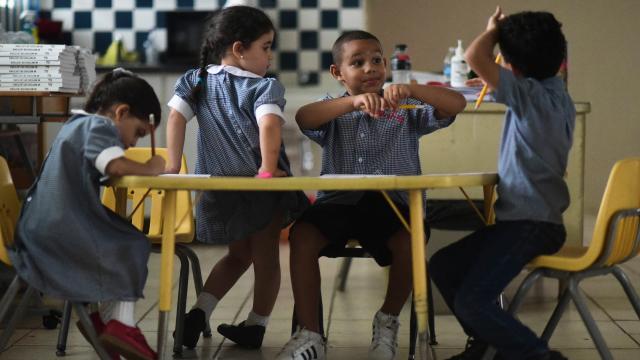Hurricane Maria was the deadliest storm in modern U.S. history. And the damage didn’t end when the storm clouds cleared back in September 2017. Especially not for Puerto Rico’s youngest.
A new study — the largest post-disaster survey ever conducted in the U.S. — found that students from grades 3 to 12 across the entire island had, to put it bluntly, gone through some serious shit. As a result, more than 7 per cent reported symptoms of post-traumatic stress disorder, or PTSD. While this isn’t exactly surprising, it’s still pretty awful.
Published in the JAMA Network Open journal last week, the study involved distributing individual surveys in Spanish to all the students in the island’s public school system between February and July 2018. It required an effective partnership between the Puerto Rico Department of Education and researchers at the Medical University of South and Carolina, Carlos Albizu University in San Juan, and the University of Mississippi. More than 96,000 students, divided equally between genders, wound up completing the survey. Kids could skip it, but those who answered remained anonymous.
The study measured the stressors and signs of PTSD using the National Child Traumatic Stress Network Hurricane Assessment and Referral Tool, which was created after Hurricane Katrina. Some of the stressors include perceived and actual threat to life, and depression was among the symptoms. There’s some concern that translating this tool in Spanish could’ve skewed the results.
Still, the results were startling. Nearly 84 per cent of these youth saw homes damaged in wake of the storm, with nearly half experiencing damage to their own homes. Nearly a quarter of these students helped rescue people. More than half saw a friend or family member flee the island. More than 30 per cent suffered food or water shortages, and nearly 30 per cent believed their lives were at risk. At the time of the surveys, some 16 per cent were still without electricity. More than 17 per cent saw theft in their neighbourhood, and some 12 per cent saw violence.
“We know from prior literature that these are all significant risk factors for developing mental health concerns long-term,” said author Rosaura Orengo Aguayo, an assistant professor of psychiatry and behavioural sciences at the Medical University of South Carolina’s National Crime Victims Research and Treatment Center, in an email to Earther. “Additionally, the fact that all children endorsed significant disaster exposure, regardless of where they were on the island, speaks to how Maria severely impacted the entire island.”
The team of scientists also found a “moderate correlation” between these stressors and the PTSD symptoms reported. Girls were most at risk for these symptoms. Initial losses, social disruption, and fear for their life were the stressors most associated with this risk.
Natural disasters often hit young people hard. In Australia, bushfires hurt some students’ academic progression. After Hurricane Florence, students in North Carolina missed weeks of classes. And then there’s mental health, which can be impacted after living through a traumatic disaster.
The Centres for Disease Control and Prevention have raised the alarm about this, and we’ve seen it happen after after Hurricane Katrina. This study only reinforces what we already knew—and shows that there’s a need for governments to be prepared to help young people get through this.
Still, the 7.2 per cent rate of potential PTSD is lower than other post-disaster studies that have found rates range from 13 to 30 per cent, said Aguayo in the email.
“This suggests that Puerto Rican children may have experienced protective factors that we did not include in this survey,” she wrote.
The authors say future studies should take a closer look at this. Until then, these teams are continuing their partnership with the Puerto Rico Department of Education by offering training for evidence-based trauma treatment to help the department provide whatever mental health services students need.
It’s been a long road to recovery for Puerto Rico, and it’s still not over.
